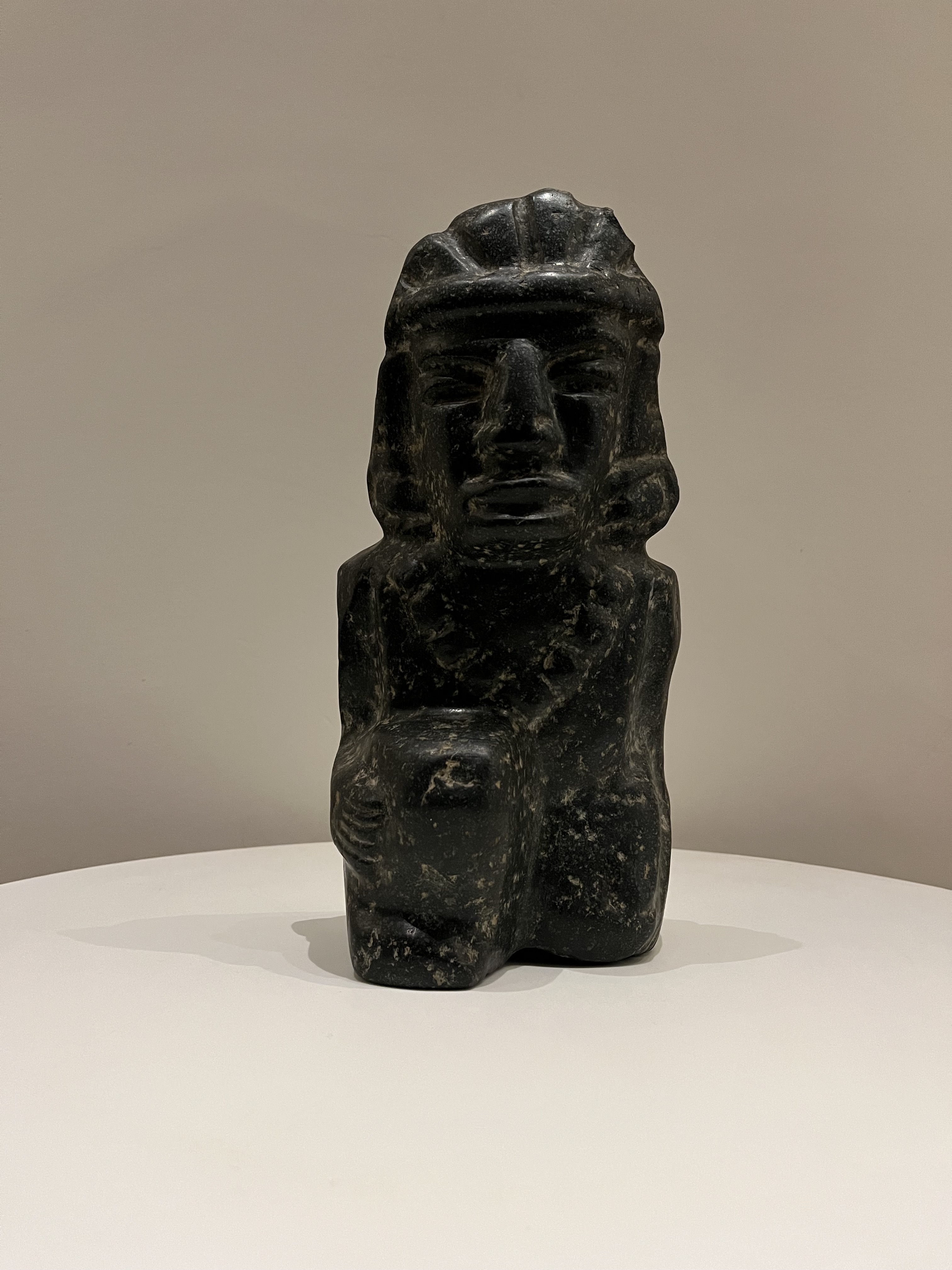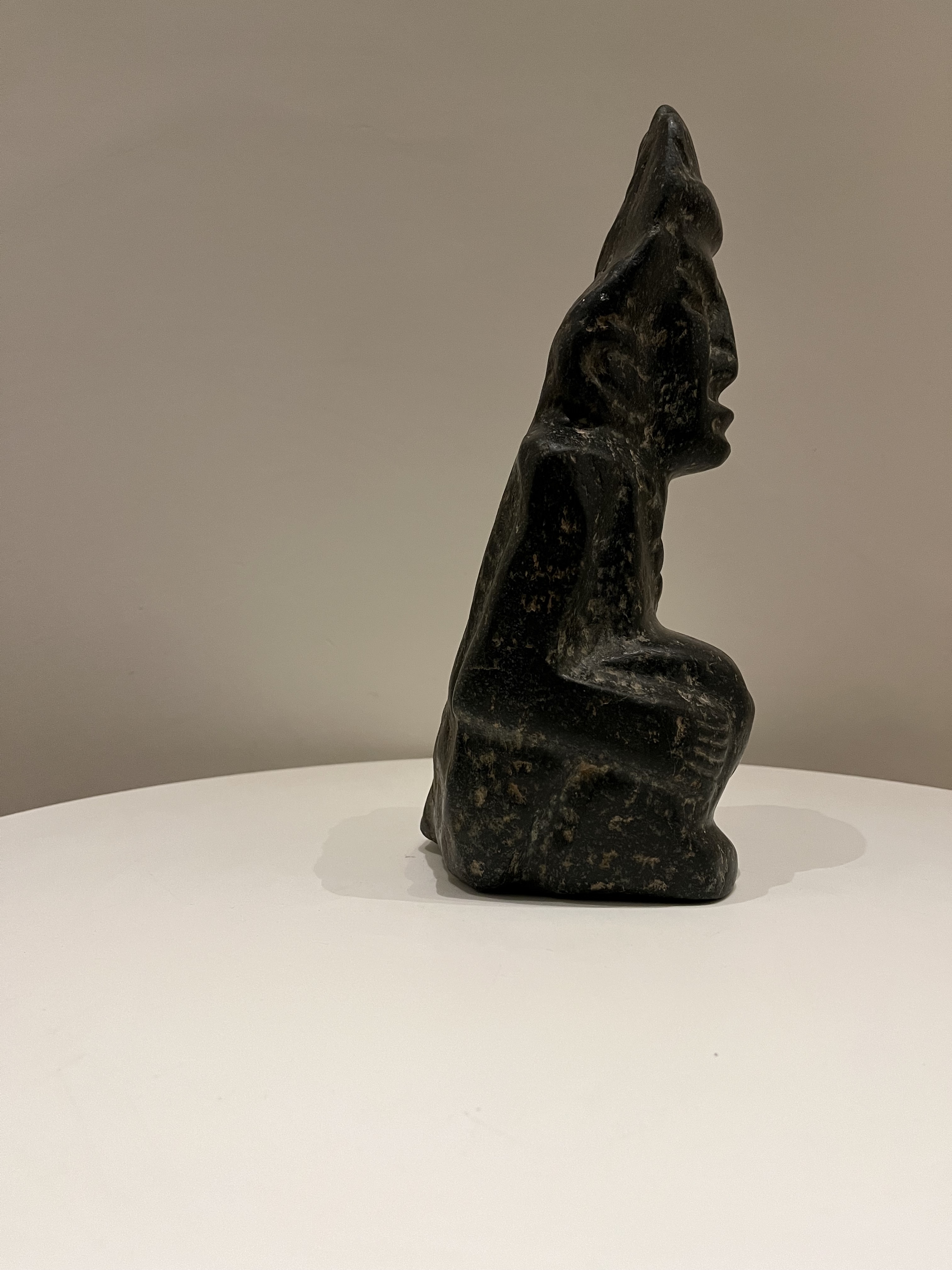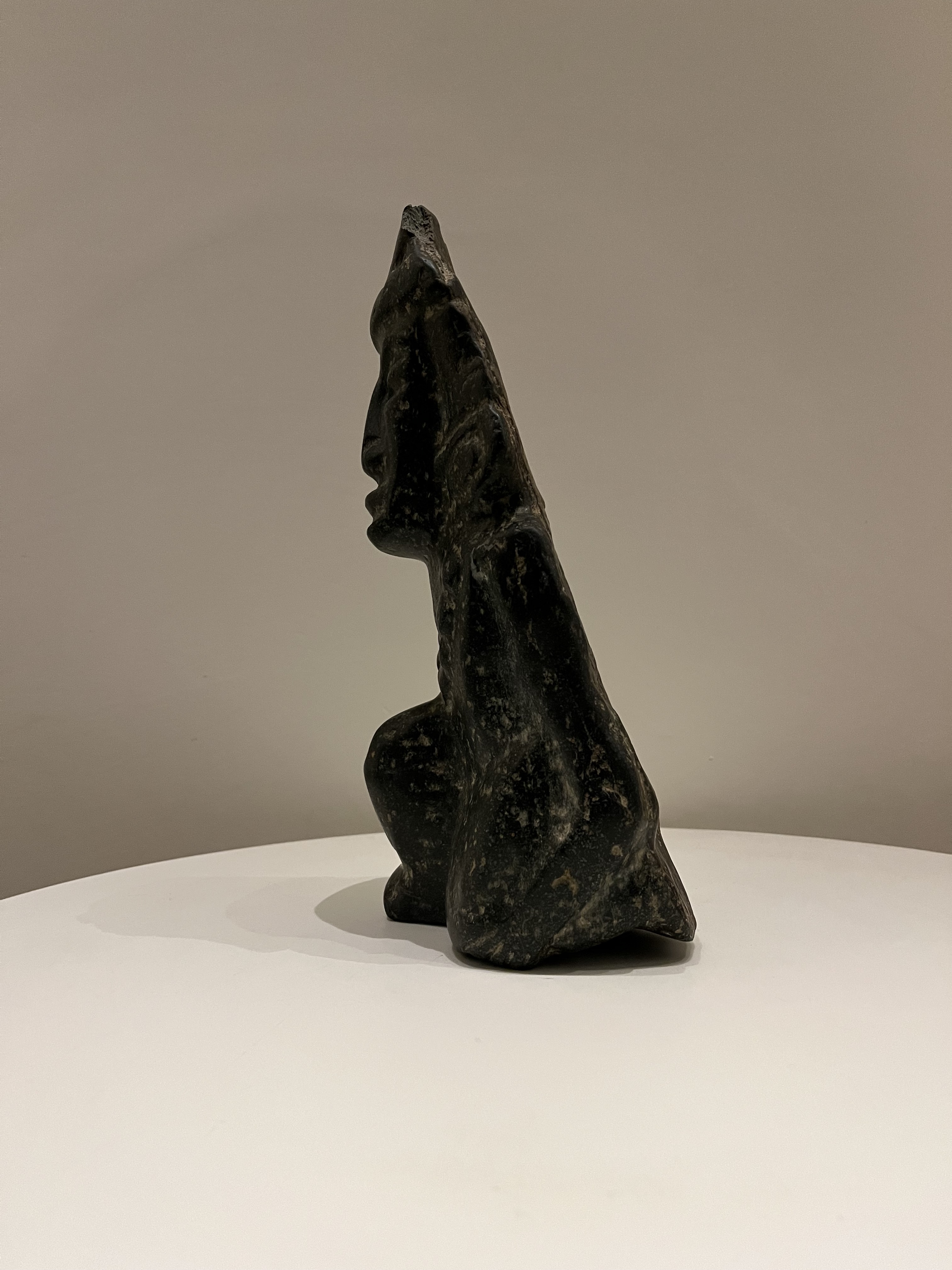122
A Rare Anthropomorphic Teotihuacano Effigy Wearing a Headdress of Quetzal Feathers
A Rare Anthropomorphic Effigy Wearing a Headdress of Quetzal Feathers, Kneeling on one Knee with Necklace and Oblong Earspools Early Teotihuacano Culture, 0-200 AD Central Mexico Grey-green diorite with brown patina Property of a Lady Provenance: Given as a gift to M. Julien Dalbin, Paris, France during his travels in Mexico in the 1940's; By descent, M. Pierre Dalton, Paris, France; By descent. Dimensions: 11.8 in (H) x 5.9 in (W) x 5.1 in (D) Lot Essay: We are grateful to Professor Michael Coe, Yale University, and Dr José Contel, Toulouse University, for their help with the attribution and origins of the effigy. The beginnings of Teotihuacan are still very much unknown and are still shrouded in mystery. What we do know is that in the Late Formative era a number of urban centres arose in central Mexico. The most prominent of these appears to have been Cuicuilco on the southern shore of Lake Texcoco. Scholars have speculated that the eruption of the Xitle volcano may have prompted a mass emigration out of the central valley and into the Teotihuacan valley. These settlers may have founded or accelerated the growth of Teotihuacan. Other scholars have put forth the Totonac people as the founders of Teotihuacan. There is evidence that at least some of the people living in Teotihuacan immigrated from those areas influenced by the Teotihuacano civilization, including the Zapotec, Mixtec, and Maya peoples. The earliest buildings at Teotihuacan date to about 200 BC. The largest pyramid, the Pyramid of the Sun, was completed by AD 100. The wide, flat headdress of this figure identifies it as having been made by early cultures of the Teotihuacano cultural region, before the Classic period city of Teotihuacan was fully established. In this rare piece we find influences and other comparable features in later Teotihuacano figurines such as facial features, necklaces, and headdresses. The feathered headdress of Mesoamerican cultures was made from quetzal feathers. The resplendent quetzal was considered divine, associated with the "snake god", Quetzalcoatl, by Pre-Columbian Mesoamerican civilisations. Its iridescent green tail-feathers, symbols for spring plant growth, were venerated by the ancient Aztecs and Maya who viewed the quetzal as the "god of the air" and as a symbol of goodness and light. The Maya also viewed the quetzal as symbolising freedom and wealth; this was due to their understanding that quetzals died in captivity, as well as the value which the Maya assigned to their feathers. Mesoamerican rulers and some nobility of other ranks wore headdresses made from quetzal feathers, symbolically connecting them to Quetzalcoatl. Since it was a crime to kill a quetzal, the bird was simply captured; its long tail feathers were plucked and it was set free. In several Mesoamerican languages, the term for quetzal can also mean precious, sacred, or erected.
A Rare Anthropomorphic Effigy Wearing a Headdress of Quetzal Feathers, Kneeling on one Knee with Necklace and Oblong Earspools Early Teotihuacano Culture, 0-200 AD Central Mexico Grey-green diorite with brown patina Property of a Lady Provenance: Given as a gift to M. Julien Dalbin, Paris, France during his travels in Mexico in the 1940's; By descent, M. Pierre Dalton, Paris, France; By descent. Dimensions: 11.8 in (H) x 5.9 in (W) x 5.1 in (D) Lot Essay: We are grateful to Professor Michael Coe, Yale University, and Dr José Contel, Toulouse University, for their help with the attribution and origins of the effigy. The beginnings of Teotihuacan are still very much unknown and are still shrouded in mystery. What we do know is that in the Late Formative era a number of urban centres arose in central Mexico. The most prominent of these appears to have been Cuicuilco on the southern shore of Lake Texcoco. Scholars have speculated that the eruption of the Xitle volcano may have prompted a mass emigration out of the central valley and into the Teotihuacan valley. These settlers may have founded or accelerated the growth of Teotihuacan. Other scholars have put forth the Totonac people as the founders of Teotihuacan. There is evidence that at least some of the people living in Teotihuacan immigrated from those areas influenced by the Teotihuacano civilization, including the Zapotec, Mixtec, and Maya peoples. The earliest buildings at Teotihuacan date to about 200 BC. The largest pyramid, the Pyramid of the Sun, was completed by AD 100. The wide, flat headdress of this figure identifies it as having been made by early cultures of the Teotihuacano cultural region, before the Classic period city of Teotihuacan was fully established. In this rare piece we find influences and other comparable features in later Teotihuacano figurines such as facial features, necklaces, and headdresses. The feathered headdress of Mesoamerican cultures was made from quetzal feathers. The resplendent quetzal was considered divine, associated with the "snake god", Quetzalcoatl, by Pre-Columbian Mesoamerican civilisations. Its iridescent green tail-feathers, symbols for spring plant growth, were venerated by the ancient Aztecs and Maya who viewed the quetzal as the "god of the air" and as a symbol of goodness and light. The Maya also viewed the quetzal as symbolising freedom and wealth; this was due to their understanding that quetzals died in captivity, as well as the value which the Maya assigned to their feathers. Mesoamerican rulers and some nobility of other ranks wore headdresses made from quetzal feathers, symbolically connecting them to Quetzalcoatl. Since it was a crime to kill a quetzal, the bird was simply captured; its long tail feathers were plucked and it was set free. In several Mesoamerican languages, the term for quetzal can also mean precious, sacred, or erected.
Summer Sale: Photographs, Old Master Paintings, Icons, Sculpture, Impressionism, and Mid-20th Century to Modern
Sale Date(s)
Venue Address
All Invoices must be paid in full before Items can be collected by your designated shipper.
We will enclose a transport and shipping form with each invoice sent to you. Under most circumstances, you must make all transport and shipping arrangements. However, we can arrange to pack, transport and ship your property if you ask us to and pay the costs of doing so. We recommend that you ask us for an estimate, especially for any large items or items of high value that need professional packing before you bid. We may also suggest other handlers, packers, transporters or experts if you ask us to do so. For more information, please contact Sloane Street Auction Galleries on +44 (0)2072 590304. We will take reasonable care when we are handling, packing, transporting and shipping a lot. However, if we recommend another company for any of these purposes, we are not responsible for their acts, failure to act or neglect.
For more information on shipping, please refer to Section 8 of our Terms and Conditions.
Important Information
Lots will be viewable from June 9th 2022 until midday on July 1st 2022 at our Lower Sloane Street Auction galleries (69 Lower Sloane Street, London, SW1W 8DA). The auction will be held close-by at 1400 GMT at the iconic Sir Christopher Wren building, Wren House, The Royal Hospital.
Terms & Conditions
For our Terms & Conditions, please click here.









